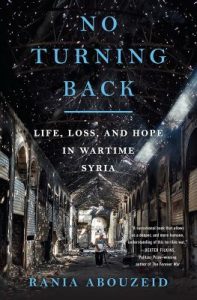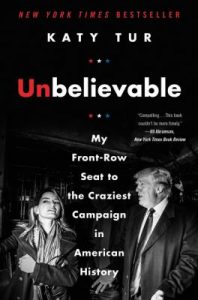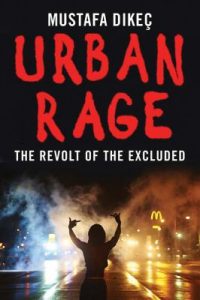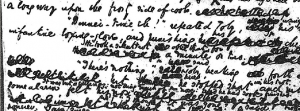Three on the Third is a monthly series in which we highlight three books new to the library collection. Summaries of the books will be provided along with shelf location and a link to the item in the catalog. This month we have three exciting new additions to our collection.
No Turning Back: Life, Loss, and Hope in Wartime Syria
by Rania Abouzeid
 This astonishing book by the prize-winning journalist Rania Abouzeid tells the tragedy of the Syrian War through the dramatic stories of four young people seeking safety and freedom in a shattered country. Extending back to the first demonstrations of 2011, No Turning Back dissects the tangle of ideologies and allegiances that make up the Syrian conflict. As protests ignited in Daraa, some citizens were brimming with a sense of possibility. A privileged young man named Suleiman posted videos of the protests online, full of hope for justice and democracy. A father of two named Mohammad, secretly radicalized and newly released from prison, saw a darker opportunity in the unrest. When violence broke out in Homs, a poet named Abu Azzam became an unlikely commander in a Free Syrian Army militia. The regime’s brutal response disrupted a family in Idlib province, where a nine-year-old girl opened the door to a military raid that caused her father to flee. As the bombings increased and roads grew more dangerous, these people’s lives intertwined in unexpected ways. Rania Abouzeid brings readers deep inside Assad’s prisons, to covert meetings where foreign states and organizations manipulated the rebels, and to the highest levels of Islamic militancy and the formation of ISIS. Based on more than five years of clandestine reporting on the front lines, No Turning Back is an utterly engrossing human drama full of vivid, indelible characters that shows how hope can flourish even amid one of the twenty-first century’s greatest humanitarian disasters.
This astonishing book by the prize-winning journalist Rania Abouzeid tells the tragedy of the Syrian War through the dramatic stories of four young people seeking safety and freedom in a shattered country. Extending back to the first demonstrations of 2011, No Turning Back dissects the tangle of ideologies and allegiances that make up the Syrian conflict. As protests ignited in Daraa, some citizens were brimming with a sense of possibility. A privileged young man named Suleiman posted videos of the protests online, full of hope for justice and democracy. A father of two named Mohammad, secretly radicalized and newly released from prison, saw a darker opportunity in the unrest. When violence broke out in Homs, a poet named Abu Azzam became an unlikely commander in a Free Syrian Army militia. The regime’s brutal response disrupted a family in Idlib province, where a nine-year-old girl opened the door to a military raid that caused her father to flee. As the bombings increased and roads grew more dangerous, these people’s lives intertwined in unexpected ways. Rania Abouzeid brings readers deep inside Assad’s prisons, to covert meetings where foreign states and organizations manipulated the rebels, and to the highest levels of Islamic militancy and the formation of ISIS. Based on more than five years of clandestine reporting on the front lines, No Turning Back is an utterly engrossing human drama full of vivid, indelible characters that shows how hope can flourish even amid one of the twenty-first century’s greatest humanitarian disasters.
DS98.6 .A26 2018
Catalog Link – No Turning Back
Unbelievable: My Front-row Seat to the Craziest Campaign in American History
by Katy Tur
 Called ‘disgraceful, ‘ ‘third-rate, ‘ and ‘not nice’ by Donald Trump, NBC News correspondent Katy Tur reported on–and took flak from–the most volatile presidential candidate in American history. Katy Tur lived out of a suitcase for a year and a half, following Trump around the country, powered by packets of peanut butter and kept clean with dry shampoo. She visited forty states with the candidate, made more than 3,800 live television reports, and tried to endure a gazillion loops of Elton John’s ‘Tiny Dancer’ — a Trump rally playlist staple. From day 1 to day 500, Tur documented Trump’s inconsistencies, fact-checked his falsities, and called him out on his lies. In return, Trump repeatedly singled Tur out. He tried to charm her, intimidate her, and shame her. At one point, he got a crowd so riled up against Tur, Secret Service agents had to walk her to her car. Through all the long nights, wild scoops, naked chauvinism, dodgy staffers, and fevered debates, no one had a better view than Tur. This is her darkly comic and often scary story of how America sent a former reality show host to the White House. It’s also the story of what it was like for Tur to be there as it happened, inside a no-rules world where reporters were spat on, demeaned, and discredited. Tur was a foreign correspondent who came home to her most foreign story of all. Unbelievable is for anyone who still wakes up and wonders, Is this real life?
Called ‘disgraceful, ‘ ‘third-rate, ‘ and ‘not nice’ by Donald Trump, NBC News correspondent Katy Tur reported on–and took flak from–the most volatile presidential candidate in American history. Katy Tur lived out of a suitcase for a year and a half, following Trump around the country, powered by packets of peanut butter and kept clean with dry shampoo. She visited forty states with the candidate, made more than 3,800 live television reports, and tried to endure a gazillion loops of Elton John’s ‘Tiny Dancer’ — a Trump rally playlist staple. From day 1 to day 500, Tur documented Trump’s inconsistencies, fact-checked his falsities, and called him out on his lies. In return, Trump repeatedly singled Tur out. He tried to charm her, intimidate her, and shame her. At one point, he got a crowd so riled up against Tur, Secret Service agents had to walk her to her car. Through all the long nights, wild scoops, naked chauvinism, dodgy staffers, and fevered debates, no one had a better view than Tur. This is her darkly comic and often scary story of how America sent a former reality show host to the White House. It’s also the story of what it was like for Tur to be there as it happened, inside a no-rules world where reporters were spat on, demeaned, and discredited. Tur was a foreign correspondent who came home to her most foreign story of all. Unbelievable is for anyone who still wakes up and wonders, Is this real life?
E911 .T87 2017
Catalog Link – Unbelievable
Urban Rage: the Revolt of the Excluded
by Mustafa Dikeç
 Riots are sweeping our cities: Cincinnati in 2001, Paris in 2005, Athens in 2008, London in 2011, Stockholm and Istanbul in 2013, Ferguson in 2014, Baltimore in 2015, and both Milwaukee and Charlotte in 2016. Unprecedented in size and scale for modern times, these uprisings have led to states of emergency, disruptions, fires and government crackdowns. Welcome to the era of urban rage. Professor Mustafa Dikec examines cities in mature democracies across the world, looking at how economic, social and political processes come together to produce concentrated poverty with severe disadvantages. While a particular police or government action may spark a revolt, Dikec shows that it is the genuine grievances overlooked by our democracies which give rise to these expressions of deep-seated rage. In this timely and incisive look at contemporary urban unrest, Dikec makes clear that change is only possible if we rethink the established practices of policing and policymaking and meet head on the failures of democratic systems.
Riots are sweeping our cities: Cincinnati in 2001, Paris in 2005, Athens in 2008, London in 2011, Stockholm and Istanbul in 2013, Ferguson in 2014, Baltimore in 2015, and both Milwaukee and Charlotte in 2016. Unprecedented in size and scale for modern times, these uprisings have led to states of emergency, disruptions, fires and government crackdowns. Welcome to the era of urban rage. Professor Mustafa Dikec examines cities in mature democracies across the world, looking at how economic, social and political processes come together to produce concentrated poverty with severe disadvantages. While a particular police or government action may spark a revolt, Dikec shows that it is the genuine grievances overlooked by our democracies which give rise to these expressions of deep-seated rage. In this timely and incisive look at contemporary urban unrest, Dikec makes clear that change is only possible if we rethink the established practices of policing and policymaking and meet head on the failures of democratic systems.
HN18.3 .D55 2017
Catalog Link – Urban Rage

 If you want to explore the most important British literary works written between 1100 and 1900,
If you want to explore the most important British literary works written between 1100 and 1900, 
 This astonishing book by the prize-winning journalist Rania Abouzeid tells the tragedy of the Syrian War through the dramatic stories of four young people seeking safety and freedom in a shattered country. Extending back to the first demonstrations of 2011, No Turning Back dissects the tangle of ideologies and allegiances that make up the Syrian conflict. As protests ignited in Daraa, some citizens were brimming with a sense of possibility. A privileged young man named Suleiman posted videos of the protests online, full of hope for justice and democracy. A father of two named Mohammad, secretly radicalized and newly released from prison, saw a darker opportunity in the unrest. When violence broke out in Homs, a poet named Abu Azzam became an unlikely commander in a Free Syrian Army militia. The regime’s brutal response disrupted a family in Idlib province, where a nine-year-old girl opened the door to a military raid that caused her father to flee. As the bombings increased and roads grew more dangerous, these people’s lives intertwined in unexpected ways. Rania Abouzeid brings readers deep inside Assad’s prisons, to covert meetings where foreign states and organizations manipulated the rebels, and to the highest levels of Islamic militancy and the formation of ISIS. Based on more than five years of clandestine reporting on the front lines, No Turning Back is an utterly engrossing human drama full of vivid, indelible characters that shows how hope can flourish even amid one of the twenty-first century’s greatest humanitarian disasters.
This astonishing book by the prize-winning journalist Rania Abouzeid tells the tragedy of the Syrian War through the dramatic stories of four young people seeking safety and freedom in a shattered country. Extending back to the first demonstrations of 2011, No Turning Back dissects the tangle of ideologies and allegiances that make up the Syrian conflict. As protests ignited in Daraa, some citizens were brimming with a sense of possibility. A privileged young man named Suleiman posted videos of the protests online, full of hope for justice and democracy. A father of two named Mohammad, secretly radicalized and newly released from prison, saw a darker opportunity in the unrest. When violence broke out in Homs, a poet named Abu Azzam became an unlikely commander in a Free Syrian Army militia. The regime’s brutal response disrupted a family in Idlib province, where a nine-year-old girl opened the door to a military raid that caused her father to flee. As the bombings increased and roads grew more dangerous, these people’s lives intertwined in unexpected ways. Rania Abouzeid brings readers deep inside Assad’s prisons, to covert meetings where foreign states and organizations manipulated the rebels, and to the highest levels of Islamic militancy and the formation of ISIS. Based on more than five years of clandestine reporting on the front lines, No Turning Back is an utterly engrossing human drama full of vivid, indelible characters that shows how hope can flourish even amid one of the twenty-first century’s greatest humanitarian disasters. Called ‘disgraceful, ‘ ‘third-rate, ‘ and ‘not nice’ by Donald Trump, NBC News correspondent Katy Tur reported on–and took flak from–the most volatile presidential candidate in American history. Katy Tur lived out of a suitcase for a year and a half, following Trump around the country, powered by packets of peanut butter and kept clean with dry shampoo. She visited forty states with the candidate, made more than 3,800 live television reports, and tried to endure a gazillion loops of Elton John’s ‘Tiny Dancer’ — a Trump rally playlist staple. From day 1 to day 500, Tur documented Trump’s inconsistencies, fact-checked his falsities, and called him out on his lies. In return, Trump repeatedly singled Tur out. He tried to charm her, intimidate her, and shame her. At one point, he got a crowd so riled up against Tur, Secret Service agents had to walk her to her car. Through all the long nights, wild scoops, naked chauvinism, dodgy staffers, and fevered debates, no one had a better view than Tur. This is her darkly comic and often scary story of how America sent a former reality show host to the White House. It’s also the story of what it was like for Tur to be there as it happened, inside a no-rules world where reporters were spat on, demeaned, and discredited. Tur was a foreign correspondent who came home to her most foreign story of all. Unbelievable is for anyone who still wakes up and wonders, Is this real life?
Called ‘disgraceful, ‘ ‘third-rate, ‘ and ‘not nice’ by Donald Trump, NBC News correspondent Katy Tur reported on–and took flak from–the most volatile presidential candidate in American history. Katy Tur lived out of a suitcase for a year and a half, following Trump around the country, powered by packets of peanut butter and kept clean with dry shampoo. She visited forty states with the candidate, made more than 3,800 live television reports, and tried to endure a gazillion loops of Elton John’s ‘Tiny Dancer’ — a Trump rally playlist staple. From day 1 to day 500, Tur documented Trump’s inconsistencies, fact-checked his falsities, and called him out on his lies. In return, Trump repeatedly singled Tur out. He tried to charm her, intimidate her, and shame her. At one point, he got a crowd so riled up against Tur, Secret Service agents had to walk her to her car. Through all the long nights, wild scoops, naked chauvinism, dodgy staffers, and fevered debates, no one had a better view than Tur. This is her darkly comic and often scary story of how America sent a former reality show host to the White House. It’s also the story of what it was like for Tur to be there as it happened, inside a no-rules world where reporters were spat on, demeaned, and discredited. Tur was a foreign correspondent who came home to her most foreign story of all. Unbelievable is for anyone who still wakes up and wonders, Is this real life? Riots are sweeping our cities: Cincinnati in 2001, Paris in 2005, Athens in 2008, London in 2011, Stockholm and Istanbul in 2013, Ferguson in 2014, Baltimore in 2015, and both Milwaukee and Charlotte in 2016. Unprecedented in size and scale for modern times, these uprisings have led to states of emergency, disruptions, fires and government crackdowns. Welcome to the era of urban rage. Professor Mustafa Dikec examines cities in mature democracies across the world, looking at how economic, social and political processes come together to produce concentrated poverty with severe disadvantages. While a particular police or government action may spark a revolt, Dikec shows that it is the genuine grievances overlooked by our democracies which give rise to these expressions of deep-seated rage. In this timely and incisive look at contemporary urban unrest, Dikec makes clear that change is only possible if we rethink the established practices of policing and policymaking and meet head on the failures of democratic systems.
Riots are sweeping our cities: Cincinnati in 2001, Paris in 2005, Athens in 2008, London in 2011, Stockholm and Istanbul in 2013, Ferguson in 2014, Baltimore in 2015, and both Milwaukee and Charlotte in 2016. Unprecedented in size and scale for modern times, these uprisings have led to states of emergency, disruptions, fires and government crackdowns. Welcome to the era of urban rage. Professor Mustafa Dikec examines cities in mature democracies across the world, looking at how economic, social and political processes come together to produce concentrated poverty with severe disadvantages. While a particular police or government action may spark a revolt, Dikec shows that it is the genuine grievances overlooked by our democracies which give rise to these expressions of deep-seated rage. In this timely and incisive look at contemporary urban unrest, Dikec makes clear that change is only possible if we rethink the established practices of policing and policymaking and meet head on the failures of democratic systems.